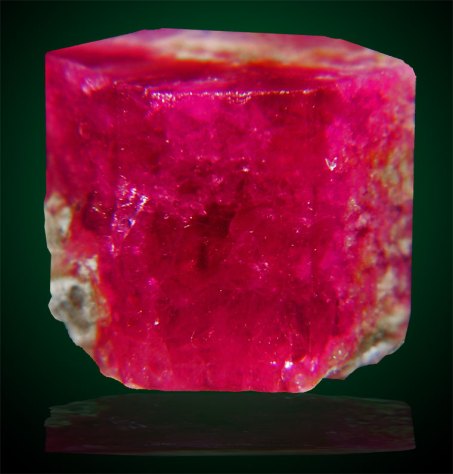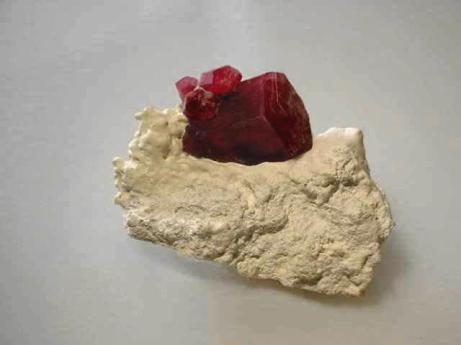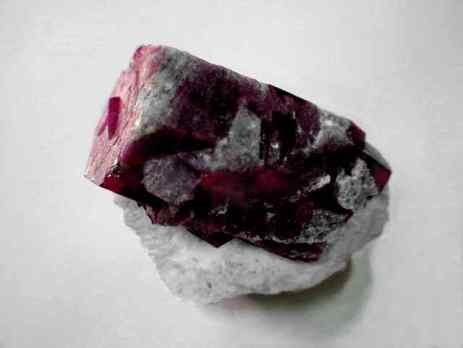12/27/2009 Emerald-Stone IV
EMERALD-The Fourth Stone
EMERALD-The Fourth Stone
Red Emerald-Bixbite
Beryl has been considered a valuable gemstone since prehistoric times. There are many colors of beryl known under many names. Green beryl is called emerald in these modern times. In the 1800s green beryl was removed from the beryl family and called emerald. Blue beryl is known as aquamarine, colorless is goshenite, pink is morganite and yellow is heliodor ranging from a bright yellow to a honey-golden yellow.
Red beryl is extremely rare and mimics shades of red from bubble gum to to scarlet, or the color of blood. Mainly found within the Wah Wah Mountains of Utah, only an estimated 60 pounds were ever mined in the history of the world! Some smaller amounts have been found in other countries recently. Oddly enough it seems people are drawn to this stone yet do not understand why. The reason will be revealed later via an excerpt from The Stones Journal.
The Color of Blood? A mystery?
The most common thread between this stone, its rarity, and the similar color of blood is in fact that the bible pounds a message to its readers that we should never forget that Jesus shed his blood for our sins. What better way to elevate the significance of that sacrifice than to mark it with the rarest gemstone in the world?
These facts seem confusing but within The Revelation Painting there is a mystery of Revelation which has been overlooked since the bible was written and it will be revealed in The Stones Journal. Once revealed, the mystery is easily seen in the painting. The price for red beryl or Bixbite is astronomical! For one brilliant and flawless, faceted carat, you can expect to pay $20,000.00 or more.
Although I have obtained 6 carats of rough stone and the collection required for this section of the painting (an estimated 272 carats) will obviously have to be forfeited in lieu of a replacement stone of similar color or some other meaningful way to express the significance of this most important section.
I once spoke to a man who had worked in the mines in Utah and asked for the owner’s contact information. He was very put off when he found that I needed to crush it for the painting. He went on to say that the stone was highly coveted and that the owner would never sacrifice it for the painting. I will never know if I do not ask, so time will tell if the mine owner will sacrifice a handful of the stone.
I turned to Ebay and the sellers there in my desperation to obtain the stone. I found many auctions but they were for outrageous prices for such small amounts of stone. My realization to crush such a rare stone was more than I could fathom. I wrote the sellers, a last stitch effort. Here is one reply after I wrote and told this seller it was the last stone I needed:
Dear Sir; This mineral is too rare, and of too small a volume mined to fit your request. If the success of your painting depends on this mineral in great quantities, I’m afraid it will never be completed. My advice is to find another source for this color. Good luck and happy painting!Kindest regards
If I had known the battle before me in obtaining this rare stone, I would have started looking 12 years ago! It was only in September 2009 that I discovered the magnitude of the stone in the New City of Revelation. There is a synthetic, or lab grown Bixbite available but I decided against it. My decision rested upon reliability of at least a red-dyed Beryl, a clear or pink Beryl. I turned to India.
Synthetic, lab grown red Beryl
African clear Beryl dyed in the reds and pinks of Bixbite
I purchased these Beryl stones for the painting due to the overwhelming inability to obtain the natural stones required. These are the only stones within the painting that do not have the ancestry or accuracy of The New City. Although discouraged, the depiction is required to move forward with the work. Only the richest reds (the color of blood) were used for this section.
Please note that every one inch section of crushed gemstones requires 6 carats of precious and semi-precious gemstones. The application is thin, requiring at times to place a coat of stain, dye or paint under the stones in their corresponding color. The decision to use undercolor (or base) is due to the color of the background’s visibility, usually apparent and profound with darker stones.
http://www.gemselect.com/other-info/bixbite-red-beryl.php
Red Beryl or Bixbite was first discovered in 1904 at Maynard Bixby’s Claim in the Thomas Mountains in western Utah, USA. Maynard Bixby (1853-1935), was an American mineralogist. Gem-quality material was not discovered until 1958 by Lamar Hodges, who was prospecting for uranium in the Wah Wah mountains of Beaver County, in southwestern Utah.
An interesting study on gemstone valuation and the rarity of the red Emerald:
http://highlinecorporation.com/Gemstone-Historical-Study.php
There is a diverse use of the color red throughout the bible associated with blood and war. It is also said that red denotes the good of love.
Direct Meaning:
skin color – Genesis 25:25
stew – Genesis 25:30
wine – Proverbs 23:31
sores or plague – Leviticus 13:19;49 etc. (numerous references in Leviticus)
bloodied water – II Kings 3:22
clothing – Isaiah 63:2
shields of mighty men – Nahum 2:3
horses – Zechariah 1:8; 6:2
the sky – Matthew 16:2-3
the great dragon (Satan) – Revelation 12:3
Color Symbolism:
war – II Kings 3:22; Nahum 2:3
vengeance – Isaiah 63:2 (read whole chapter)
temptation of sin – Genesis 25:30, Proverbs 23:31
Associated Symbols:
wine – teachings, both true and false (fermented), shame (Genesis 9:21-25; 19:31-36)
winepress – God’s judgment of the wicked (Revelation 14:19-20)
blood – see crimson
Blood is the color red that the bible said in blood is the sins of the world, “only in the blood of the lamb we shall be clean which is Christ our Lord”.
Sin, guilt, pain, passion, blood, and anger
Red is used as a symbol of guilt, sin and anger, often as connected with blood or sex. A Biblical example is found in Isaiah: “Though your sins be as scarlet, they shall be white as snow.” Also, The Scarlet Letter, an 1850 American novel by Nathaniel Hawthorne, features a woman in a Puritan New England community who is punished for adultery with ostracism, her sin represented by a red letter ‘A’ sewn into her clothes.
This all comes from a general Hebrew view inherited by Christianity which associates red with the blood of murder, as well as with guilt in general. Often, things will be in red to scare. Another popular example of this is in the phrase “caught red-handed”, meaning either caught in an act of crime or caught with the blood of murder still on one’s hands.
At one point, red was associated with prostitutes, or now, with brothels (red-light districts). In Roman Catholicism, red represents wrath, one of the Seven Deadly Sins. In Christianity, Satan is usually depicted as colored red and/or wearing a red costume in both iconography and popular culture. Statistics have shown that red cars are more likely to be involved in accidents.
The color red is associated with lust, passion, love, and beauty as well. The association with love and beauty is possibly related to the use of red roses as a love symbol. Both the Greeks and the Hebrews considered red a symbol of love, as well as sacrifice. Psychological research has shown that men find women who are wearing red more attractive. http://en.wikipedia.org/wiki/Red
Early on in 2006, the Jewelers Association named Bixbite as the rarest gemstone on earth. This replaced Benitoite as the rarest gem, a standing that Benitoite has held for many years. Bixbite prices soared, and the amount of gem available became scarce. News of a new source of Bixbite in Madagascar proved to be wrong. There was a gem being mined there, but it’s chemical composition was slightly different.
This new gem contained Lithium, which Bixbite doesn’t have. Also, the new gem’s crystals grew in a different formation. This was NOT a new source for Bixbite, but something altogether new. The new gem became known as Pezzottaite. It is very similar to Bixbite in appearance, but a trained gemologist can tell the difference. The refractive index is different, as is the density and specific gravity of the stone…http://tinyurl.com/2d9odyz
The gemstone has several different names: red beryl, red emerald, or bixbite. Originally, the mineral was named bixbite, but now red beryl is the most accepted designation. Red beryl is estimated to be worth 1,000 times more than gold and is so rare that one red beryl crystal is found for every 150,000 diamonds.
In 1904, Maynard Bixby discovered red beryl in the Thomas Range located in Juab County, Utah. Bixby thought it might be a new variety of beryl, but the raspberry- red color did not correlate with any beryl known to exist at that time (green, blue, pink, yellow, and clear/white). W.F. Hillebrand, a geochemist from the National College in Washington, D.C., identified the mineral as a new type of beryl in 1905.
In 1912, Dr. A. Eppler named it bixbite in honor of its discoverer. Laboratory analysis showed that manganese and small amounts of iron, chromium, and calcium create the raspberry-red color of red beryl. Like other beryl, red beryl has a hardness of 7.5 to 8.0 and its chemical composition is Be3Al2Si6O18.
Red beryl formation began with the eruption of a topaz rhyolite lava from volcanic vents. As the lava began to cool, shrinkage cracks formed, creating pathways for hightemperature gases rich in beryllium to escape. Oxidized surface water also began seeping into these cracks and mixed with the rising beryllium gases. The gases reacted with the surface water, silica, alkali feldspar, and ironmanganese oxides from the lava to form red beryl crystals.
Red beryl probably grew at temperatures between 300 to 650 degrees Celsius. Red beryl is presently found at only three locations in the world: the Thomas Range and the Wah Wah Mountains in west-central Utah, and the Black Range in New Mexico.
In the Thomas Range, red beryl occurs primarily as short, flat, hexagonal crystals or more rarely as elongated, barrelshaped crystals. The crystals are generally up to 2 –10 mm long and 4 – 6 mm thick. Many of these crystals are too small to be faceted. They are found in cavities and fractures within the Topaz Mountain rhyolite that erupted approximately 6 to 7 million years ago from volcanic vents in the area.
Small crystals can be found in an area called “the Cove,” where they may be attached to other minerals such as topaz, bixbyite, garnet, pseudobrookite, or hematite. Larger crystals that have been faceted into gemstones have been found in the northwest part of the Thomas Range near Wildhorse Springs.
The only known deposit of large, gem-quality red beryl in the world is from the Ruby-Violet claims in the Wah Wah Mountains of Beaver County, Utah. These are private claims and no collecting is allowed without permission from the present claim owners.
The crystals occur primarily as elongated hexagonal crystals that are up to 15 mm in length, and the largest crystal discovered to date is 14 mm wide and 34 mm long. Red beryl is generally found along large, near-vertical, northwest-trending fractures and clay-filled seams within the rhyolite member of the Blawn Formation. The rhyolite erupted approximately 18 to 20 million years ago from volcanic vents in the area.
The property has periodically been worked and continues to produce nice mineral specimens and stones suitable for faceting. Red beryl crystals from this location that have been faceted sell for an average of $2,000 per carat. For comparison, gold is currently worth $300 to $320 per ounce (one ounce is equal to 155 carats).
For more information regarding red beryl, contact the Natural Resources Map & Bookstore – (801) 537-3320, or toll free at 1 (888) UTAHMAP. The bookstore has several rock and mineral publications available for purchase that describe areas where to collect red beryl.
http://geology.utah.gov/surveynotes/gladasked/gladberyl.htm
http://www.mtlilygems.com/mineinfo/rubyviolet1.html
UTAH, U.S.A
http://www.lib.utexas.edu/maps/utah.html
The Wah Wah Mountains are a north-south trending range in west-central Utah, part of the larger Basin and Range Province. It is bound by Pine Valley to the west, Wah Wah Valley to the east, the Escalante Desert to the south, and on trend with the Confusion Range to the north. The Wah Wah Mountains are located in Beaver and Millard counties. State Route 21 bisects the range, crossing over Wah Wah Summit at about 6,500 feet (1,980 m) above sea level. Elevations range from about 6,000 feet (1,800 m) at the mountain front to 9,393 feet (2,863 m) in the southern Wah Wahs.
The “Wah Wah” name comes from Wah Wah Springs, on the eastern slope of the mountain range. “Wah Wah” is reported to mean “good clear water”. The Bureau of Land Management, which administers most of the land within the Wah Wah Mountains, has designated two wilderness study areas, one in the north and one in the central portion of the range.
The Wah Wah Mountains are made up of Neoproterozoic– to Paleozoic-aged sedimentary rocks (limestone, dolomite, shale, and sandstone metamorphized into quartzite), overlain by younger Tertiary volcanic rocks (basalt, andesite, dacite, rhyolite, and tuff) on the eastern flank of the range. A series of thrust faults cut through the sedimentary rocks in the southern end of the range.
The Wah Wah Mountains are made up of Neoproterozoic– to Paleozoic-aged sedimentary rocks (limestone, dolomite, shale, and sandstone metamorphized into quartzite), overlain by younger Tertiary volcanic rocks (basalt, andesite, dacite, rhyolite, and tuff) on the eastern flank of the range. A series of thrust faults cut through the sedimentary rocks in the southern end of the range.
It is notable as the source of a rare red beryl gemstone, which is mined commercially. Perhaps, the most famous geologic feature is Crystal Peak, in the northern part of the range (near the pass between the Wah Wah Mountains and the Confusion Range). It is an erosional remnant of a Paleogene rhyolite tuff that has abundant doubly terminated crystals of quartz.
http://en.wikipedia.org/wiki/Wah_Wah_Mountains
There is not much information for this area regarding the people or culture, but there is this warning:
The primary goal the environmentalists have in wanting to declare parts of this area as Wilderness, is to have solitude. This whole latilong has lots of solitude. If you were off the beaten path with a breakdown, it might be weeks before someone came your way. As it is, even on the main highway, Highway 21, vehicles are few and far between.
Be warned. If you drive out here, prepare. Let others know your schedule and travel routes and ask them to send for help if you don’t show up when expected. Take lots more water than you think you will need. Take warm clothes, a hat and good boots. Some cellular providers show this area as working. Both Cellular 1 and AT+T have coverage maps that imply most of the latilong is covered. Click here and enter Milford’s zip code, 84751 to see the Cellular 1 coverage map. You will need analog capabilities to roam here and even that may not work depending what mountains you are behind.
http://www.utahnature.com/journals/wahwahgeography.php
“Red Beryl crystals of this size on matrix are quite rare and valuable. The only Beryl’s in the world which have this distinctive deep blood red color come from the state of Utah.”
http://www.rockhounds.com/rockshop/redber4.html
- Leave a comment
- Posted under EMERALD, Uncategorized







Leave a comment